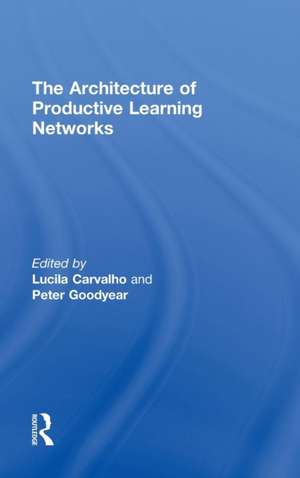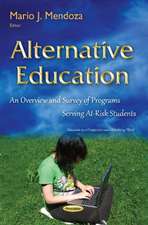The Architecture of Productive Learning Networks
Autor Lucila Carvalho, Peter Goodyearen Limba Engleză Hardback – 7 mar 2014
The book introduces a framework for analyzing learning networks to show how knowledge, human interaction and physical and digital resources combine in the operation of productive learning networks. The book also argues that learning through interaction in networks has a long history. It combines ideas from architecture, anthropology, archaeology, education, sociology and organizational theory to illustrate and understand networked forms of learning.
| Toate formatele și edițiile | Preț | Express |
|---|---|---|
| Paperback (1) | 388.42 lei 6-8 săpt. | |
| Taylor & Francis – 4 mar 2014 | 388.42 lei 6-8 săpt. | |
| Hardback (1) | 1057.89 lei 6-8 săpt. | |
| Taylor & Francis – 7 mar 2014 | 1057.89 lei 6-8 săpt. |
Preț: 1057.89 lei
Preț vechi: 1290.10 lei
-18% Nou
Puncte Express: 1587
Preț estimativ în valută:
202.42€ • 211.37$ • 167.16£
202.42€ • 211.37$ • 167.16£
Carte tipărită la comandă
Livrare economică 15-29 aprilie
Preluare comenzi: 021 569.72.76
Specificații
ISBN-13: 9780415816557
ISBN-10: 0415816556
Pagini: 312
Dimensiuni: 152 x 229 x 18 mm
Greutate: 0.54 kg
Ediția:New.
Editura: Taylor & Francis
Colecția Routledge
Locul publicării:Oxford, United Kingdom
ISBN-10: 0415816556
Pagini: 312
Dimensiuni: 152 x 229 x 18 mm
Greutate: 0.54 kg
Ediția:New.
Editura: Taylor & Francis
Colecția Routledge
Locul publicării:Oxford, United Kingdom
Cuprins
Part One: Foundations
1 Introduction: networked learning and learning networks
Peter Goodyear and Lucila Carvalho
2 Productive learning networks: the evolution of research and practice
Peter Goodyear
3 Framing the analysis of learning network architectures
Peter Goodyear and Lucila Carvalho
Part Two: Learning Networks
4 Peep: peer support for programing
Lucila Carvalho, Peter Goodyear, Dewa Wardak and Rob Saunders
5 Creating a peer-driven learning network in higher education – using Web 2.0 tools to facilitate online dialogue and collaboration
Hanne Westh Nicolajsen and Thomas Ryberg
6 Professional learning and a national community of practice for teachers leading local curriculum change
Lynn Robinson and Jaime Metcher
7 One Laptop Per Child (OLPC): a small computer to serve a big cause
Martin Parisio, Kate Thompson, Tracy Richardson and Rangan Srikhanta
8 Diseña el Cambio: helping Mexican school children to design a better world
Crighton Nichols and David Ashe
9 Biebkracht: library professionals empowered through an inter-organizational learning network – design principles and evolution
Marlies Bitter-Rijpkema, Steven Verjans, Wim Didderen and Peter Sloep
10 Qstream: learning in the ‘in-between’
David Ashe, Pippa Yeoman and Tim Shaw
11 ISQua Knowledge: fostering a sense of community for the emerging field of quality in health care
Dewa Wardak, Paul Parker and Tim Shaw
12 The Synaptic Leap: open science combating disease
Paul Parker, Beat Schwendimann, Kate Thompson and Matthew Todd
13 Virtual Choir: sharing experiences of singing together apart
Lucila Carvalho and Peter Goodyear
14 iSpot: your place to share nature
Ana Pinto, Kate Thompson, Chris Jones, and Doug Clow
15 Utilizing informal teacher professional development networks using the Network Awareness Tool
Maarten de Laat, Bieke Schreurs and Rory Sie
Part Three: Synthesis
16 Synthesis: set design, epistemic design and the functioning of learning networks
Lucila Carvalho and Peter Goodyear
Contributors
Index
1 Introduction: networked learning and learning networks
Peter Goodyear and Lucila Carvalho
2 Productive learning networks: the evolution of research and practice
Peter Goodyear
3 Framing the analysis of learning network architectures
Peter Goodyear and Lucila Carvalho
Part Two: Learning Networks
4 Peep: peer support for programing
Lucila Carvalho, Peter Goodyear, Dewa Wardak and Rob Saunders
5 Creating a peer-driven learning network in higher education – using Web 2.0 tools to facilitate online dialogue and collaboration
Hanne Westh Nicolajsen and Thomas Ryberg
6 Professional learning and a national community of practice for teachers leading local curriculum change
Lynn Robinson and Jaime Metcher
7 One Laptop Per Child (OLPC): a small computer to serve a big cause
Martin Parisio, Kate Thompson, Tracy Richardson and Rangan Srikhanta
8 Diseña el Cambio: helping Mexican school children to design a better world
Crighton Nichols and David Ashe
9 Biebkracht: library professionals empowered through an inter-organizational learning network – design principles and evolution
Marlies Bitter-Rijpkema, Steven Verjans, Wim Didderen and Peter Sloep
10 Qstream: learning in the ‘in-between’
David Ashe, Pippa Yeoman and Tim Shaw
11 ISQua Knowledge: fostering a sense of community for the emerging field of quality in health care
Dewa Wardak, Paul Parker and Tim Shaw
12 The Synaptic Leap: open science combating disease
Paul Parker, Beat Schwendimann, Kate Thompson and Matthew Todd
13 Virtual Choir: sharing experiences of singing together apart
Lucila Carvalho and Peter Goodyear
14 iSpot: your place to share nature
Ana Pinto, Kate Thompson, Chris Jones, and Doug Clow
15 Utilizing informal teacher professional development networks using the Network Awareness Tool
Maarten de Laat, Bieke Schreurs and Rory Sie
Part Three: Synthesis
16 Synthesis: set design, epistemic design and the functioning of learning networks
Lucila Carvalho and Peter Goodyear
Contributors
Index
Notă biografică
Lucila Carvalho is a Postdoctoral Research Associate in the CoCo Research Centre at the University of Sydney, Australia. Her PhD combined research in design, learning technology and the sociology of knowledge. She has studied and carried out research in Australia, New Zealand, the UK and Brazil. She has presented her work at various international conferences in the fields of education, sociology, systemic functional linguistics, design and software engineering.
Peter Goodyear is Professor of Education, Australian Laureate Fellow and Co-Director of the CoCo Research Centre at the University of Sydney, Australia. He has been carrying out research in the field of learning and technology since the early 1980s, working in the UK, Europe and Australia. He has published eight books and over 100 journal articles and book chapters.
Peter Goodyear is Professor of Education, Australian Laureate Fellow and Co-Director of the CoCo Research Centre at the University of Sydney, Australia. He has been carrying out research in the field of learning and technology since the early 1980s, working in the UK, Europe and Australia. He has published eight books and over 100 journal articles and book chapters.
Recenzii
"Since the dawn of history, networks have been the primary source of learning. In this volume, the reader will learn about how technological innovations extend and reconfigure opportunities for networking in unexpected and exciting directions. A most welcome account of how we may design future learning."
--Professor Roger Säljö, Director of the Linnaeus Centre for Research on Learning, Interaction and Mediated Communication in Contemporary Society (LinCS), University of Gothenburg, Sweden
"In this important new work, Carvalho and Goodyear deepen our understanding of ‘learning networks as assemblages of tools, artifacts, people, ideas and practices.’ The text succeeds in extracting important architectural patterns of productive network activity, thereby helping us to re-contextualize social learning practices of the past and create new, emergent learning possibilities for our networked lives."
--Dr. Terry Anderson, Professor in Distance Education, Athabasca University, Canada; co-author of Teaching Crowds: Learning and Social Media
"Carvalho and Goodyear fuse learning theory and architecture in a stimulating exploration of how to design networks for social learning. I recommend it to anyone who wants to understand or invent the future of learning." --Dr. Mike Sharples, Professor of Educational Technology, The Open University, UK; Academic Lead at Futurelearn
"This volume offers a fresh prospect on networked learning, drawing on architectural imagining as a leitmotif. I recommend it to all designers of instructional systems--it will change the way that you think about what you do."
--Timothy Koschmann, Southern Illinois University
"It is exciting to read the case studies about the designs (architectures) for productive Learning Networks that have been used for a variety of topic areas in Australia, Mexico, the Netherlands, and around the world. A valuable collection for online teachers and researchers that illustrates how particular design solutions facilitate and shape learning activities and outcomes."
--Starr Roxanne Hiltz, author of The Virtual Classroom: Learning Without Limits via Computer Networks (1994), and co-author of Learning Networks (1997) and Learning Together Online (2005).
"The Architecture of Productive Learning Networks brings together an intriguing and insightful set of ideas and concepts to develop an architectural framework for analysing learning networks design. The book is full of fascinating case study examples to which the framework is applied. Each case study is written by experienced networked learning researchers and designers. The book editors assist the reader throughout the book with their thoughtful introduction to the framework and synthesis of the case studies. They draw on an array of valuable ideas that offer new ways to theorise and generate knowledge for design. This book is definitely a welcome and important addition to the field of networked learning and design for learning."
--Vivien Hodgson, Professor of Networked Managment Learning, Lancaster University Management School, UK
--Professor Roger Säljö, Director of the Linnaeus Centre for Research on Learning, Interaction and Mediated Communication in Contemporary Society (LinCS), University of Gothenburg, Sweden
"In this important new work, Carvalho and Goodyear deepen our understanding of ‘learning networks as assemblages of tools, artifacts, people, ideas and practices.’ The text succeeds in extracting important architectural patterns of productive network activity, thereby helping us to re-contextualize social learning practices of the past and create new, emergent learning possibilities for our networked lives."
--Dr. Terry Anderson, Professor in Distance Education, Athabasca University, Canada; co-author of Teaching Crowds: Learning and Social Media
"Carvalho and Goodyear fuse learning theory and architecture in a stimulating exploration of how to design networks for social learning. I recommend it to anyone who wants to understand or invent the future of learning." --Dr. Mike Sharples, Professor of Educational Technology, The Open University, UK; Academic Lead at Futurelearn
"This volume offers a fresh prospect on networked learning, drawing on architectural imagining as a leitmotif. I recommend it to all designers of instructional systems--it will change the way that you think about what you do."
--Timothy Koschmann, Southern Illinois University
"It is exciting to read the case studies about the designs (architectures) for productive Learning Networks that have been used for a variety of topic areas in Australia, Mexico, the Netherlands, and around the world. A valuable collection for online teachers and researchers that illustrates how particular design solutions facilitate and shape learning activities and outcomes."
--Starr Roxanne Hiltz, author of The Virtual Classroom: Learning Without Limits via Computer Networks (1994), and co-author of Learning Networks (1997) and Learning Together Online (2005).
"The Architecture of Productive Learning Networks brings together an intriguing and insightful set of ideas and concepts to develop an architectural framework for analysing learning networks design. The book is full of fascinating case study examples to which the framework is applied. Each case study is written by experienced networked learning researchers and designers. The book editors assist the reader throughout the book with their thoughtful introduction to the framework and synthesis of the case studies. They draw on an array of valuable ideas that offer new ways to theorise and generate knowledge for design. This book is definitely a welcome and important addition to the field of networked learning and design for learning."
--Vivien Hodgson, Professor of Networked Managment Learning, Lancaster University Management School, UK
Descriere
The Architecture of Productive Learning Networks explores the characteristics of productive networked learning situations and, through a series of case studies, identifies some of the key qualities of successful designs.
















